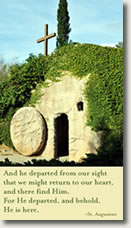Palm Sunday: The Two Processions
This is the day known as Palm Sunday, the Sunday of the Passion, a day unlike any other. It is a day of confusion and contradictions, of both ecstasy and agony, of crowds of people crying out, "Hosanna! Blessed is the One who comes in the name of the Lord!" But then later, the very same voices say, "Away with him! Crucify him!" It's a day of hopeful yet tenuous joy, a day of courage and then of fear, a day when we hear of victory — and then defeat — and then finally, victory again.Yet there is one thing for certain: Jesus is the focus of this day. He is the central figure in this drama that unfolds year after year, a drama in which you and I are players and in which the very life of Jesus is at stake. And perhaps this is where the power and the lasting significance of this day lie, for in this drama of Jesus and of the events of Palm Sunday, our lives — your life and mine — are at stake as well.
Now, I want you to be aware that two great processions are a part of today's liturgy— not just one, but two. The first procession is where we cry out with the people of Jerusalem, "Hosanna!, Hosanna in the highest! Blessed is the One who comes in the name of the Lord!" How joyous and hopeful this procession is! We join it with our hearts beating and our minds daring to contemplate what might be. But then, all too soon, the sounds of "Hosanna!" fade away, and with the crowds of people we too give voice to that other cry, so chilling and so different: "Crucify him! Crucify him!" And then the other processions begins, the procession that sets out for Golgotha and the cross. The crowds seem subdued now. They somehow seem to know that this procession, this event, is bigger than life itself, and that for all humanity and all time, nothing will ever be the same again.
So what is the great thing that is happening here? I believe it is this: That Jesus so identified himself with us and with our humanity, that in him everything — every characteristic that we know as human — is embodied, is personified in his person. And if that's so, then what we must understand in the readings today, and what we must see in this Jesus as he enters Jerusalem and as he stands before Pilate and as he makes his way to Golgotha is nothing less than what we ourselves have done, and not just to Jesus alone, but to the wholeness of humanity —how we have broken it and scarred it, how we have diminished in it the very beauty and wonder for which God is longing even now.
Reflecting on the
suffering of the crucifixion and its cruelty to humanity itself, a friend of
mine has written this: that it is only through Jesus' becoming fully human that
he could actually enter and be caught up in the cycle of our human
self-destructive violence. And only through him could God get near enough to end
this cycle with the blessings of healing, reconciliation and reunion. It is only
through the fullness of the humanness of Jesus that God can save the fullness of
our humanness as well.
So, all of this on a Sunday recalling two
processions. Such ironies are in them: the joyful, triumphant procession of
palms actually leading Jesus to conviction and to death on a cross; and the
slow, agonizing procession to Golgotha, leading to the very essence and power of
life itself, not just for Jesus, but for you and for me and for all humanity as
well. So I wonder, which of these two processions do you and do I wish to be a
part of? I think we need to be fully a part of them both.
Amen.
Copyright 2000 Calvary Episcopal Church.
